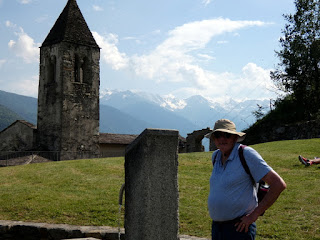We headed out to a little hill town this morning to see a water-driven grist mill that specialized in buckwheat. Buckwheat is an important crop here because it is ready to harvest in just 3 months. The other crop, rye, grows in the other nine months and is another staple. Because both these grains are gluten free and uniquely suited to the environment in the northern hills, many people are gluten-intolerant because the ability to digest gluten-based flours was not an evolutionary advantage. This watermill was built in the 1700s, and there used to be lots of them: 33 in this area and another 528 in the surrounding areas. Like grist mills in the US, the water turns a wheel which turns other parts to grind the grain and separate the bran from the flour. There was a little museum, and we were taken through the process used in the distant past to raise and process the buckwheat and rye.
 |
We climbed above the valley we were staying in and
got great views of the countryside and the Alps to the north. |
 |
| The hill village has narrow streets like we do. |
 |
Wood is a primary heating material, but is cut smaller than
we do at home so it will fit the wood stoves. |
 |
| The mill with the waterwheel |
 |
| OLD storage shed |
 |
| Various tools used in the grain harvesting process. |
 |
This is the mill -- hopper for grain in the background, with
two granite stones below: one statioinary, one turned by
the waterwheel. The big bin is for flour and the bran goes
in a bin on the left. |
 |
There was water from a spring and a pipe. The
pipe provided the primary grinding force. There
is apparently a way to turn the pipe off. |
 |
| This was used for crushing other grains with the waterwheel. |
 |
The old way of threshing the grain to separate the good
stuff from the stalks. Jim and I were both induced to try. |
Then we headed off to a cooking school that specializes in a tradtional buckwheat pasta to safeguard the original recipe. We each got a chance to make the pizzocchero noodles and then had a lunch with the traditional noodle dish as the main course. In addition to the buckwheat noodles, there is cabbage, potatoes, a softish cheese and (for four servings) nearly a pound of butter. Lunch also featured a lettuce/cabbage salad with buckwheat cheese balls. Desert was a choice of a triangle of buckwheat cake with a blueberry inner layer or ice cream with local herbs. Jim and I ordered one of each to split, but he got to eat most of the ice cream. The herb blend was only a bit noticeable on the top layer of ice cream, but as you dipped deeper into the bowl, it was more pronounced, very bitter, and generally inedible.
 |
Jim and I produced a pile of pasta that looked a LOT like
the professional version! |
 |
| Our instructor with her grandson |
 |
| Proof of our competence! |
Back at the hotel, we had about an hour to regroup before hiking to a monastery about 800 feet above the town. There are two paths -- one short and steep and the other long and gentle. Because both had lots of loose rocks, we took the steep one up and the gentle one down. This was much easier than the hike fron hell a couple days ago, although it was a similar length. We walked more slowly as a group on the downhill and flat sections than Jim and I would have on our own, and it took about 1.5 hours. The views from the top were great and I was pleased that I didn't feel totally wiped out at the end.
 |
Basilica on the right, our target monastery
at the top |
 |
Inside the Basilica -- a stained glass window
and the organ. |
 |
| Alps above us |
 |
| Zoomed in view of the monastery |
 |
| Photo op for me to rest and pretend I cared about the view. |
 |
| Monastery |
 |
| View from the top |
 |
On the gentler path down, I spied these
steps in the wall to the level above. |
 |
| Vicious attack Chihuahua who charged me in town. |
 |
These devices in front of parking spaces are remote controlled
and prevent interlopers from acquiring a reserved space. |
This was also the evening we had dinner with a local family, so we desperately needed to clean up after our exertion. Imagine our surprise when the wife in our family grew up in the bay area and met her husband when he was the sommelier on an Alaskan cruise she took! They dated for a couple years and when they got married, a cruise vocation was no longer so good, so he moved back to Italy to take over the family's apple farm. Apple trees here are short and thin -- they are trained to grow on frames, and only about 6 feet tall and a foot or two wide. It makes the apples a lot easier to pick, and it appears that there are more apples, relatively, than the more typical globular tree. I guess when there is not so much tree to grow, the tree invests more in the fruit. The only downside is that these skinny trellised trees are only productive for about 10 years, vs. 40 for a typical tree in the US. It was a delightful evening, but quite different from the larger group that visited the Finnish couple on our last tour.
































No comments:
Post a Comment